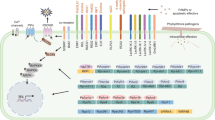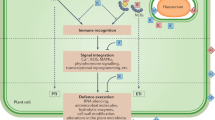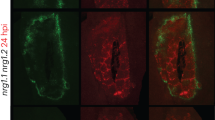Abstract
A fundamental objective in studying host-pathogen interactions is to determine how a pathogen evolves to overcome the defences of a previously resistant host. In mammalian systems, evolution of a pathogen population is often directed towards avoiding recognition by an immune system1–3. Although plants lack circulating antibodies and the memory response of mammalian immune systems, it is becoming increasingly clear that active resistance in plants involves recognition of the pathogen by its host4,5. In this paper we present the first molecular evidence to indicate that plant pathogens evolve to overcome resistance by evading host recognition and response. The bacterial pathogen Xanthomonas campestris pathovar vesicatoria mutates to overcome genetically defined resistance in pepper, Capsicum annuum, by the transposon-induced mutation of avrBs1 a bacterial gene that provokes the plant's resistance response.
Similar content being viewed by others
References
Palese, P., & Young, J. F. in Genetics of Influenza Viruses (eds Palese, P. & Kingsbury, D. W. 321–336 (Springer, Vienna, 1983).
Silverman, M. & Simon, M. in Mobile Genetic Elements (ed. Shapiro, J. A.) 537–557 (Academic, New York, 1983).
Van der Ploeg, L. H. T. Cell 51, 159–161 (1987).
Keen, N. in Advances in Plant Pathology Vol. I (eds Ingram, D. S. & Williams, P. H.) 35–83 (Academic, New York, 1982).
Ralton, J. E., Howlett, B. J. & Clarke, A. E. in Intercellular and Intracellular Communication I. Hormones, Receptors and Cellular Interactions in Plants (eds Chadwick, C. M. & Garrod, D. R.) 281–318 (Cambridge University Press, New York, 1986).
Cox, R. S., Conover, R. A. & Sowell, G. Phytopathology 46, 582–589 (1956).
Diab, S., Bashan, Y., Okom, Y. & Henis, Y. Phytopathology 72, 1257–1260 (1982).
Kennedy, B. W. & Alcorn, S. M. Pl. Dis. 64, 674–676 (1980).
Klement, Z. in Phytopathogenic Prokaryotes Vol. 2 (eds Mount, M. S. & Lacy, G. H.) 149–177 (Academic, New York, 1982).
Cook, A. A. & Stall, R. E. Pl. Dis. 66, 388–389 (1982).
Dahlbeck, D. & Stall, R. E. Phytopathology 69, 634–636 (1979).
Swanson, J., Kearney, B., Dahlbeck, D. & Staskawicz, B. Molec. Pl. Microbe Interact. 1, 5–9 (1988).
Staskawicz, B., Dahlbeck, D., Keen, N. & Napoli, C. J. Bacteriol. 169, 5789–5794 (1987).
Vieira, J. & Messing, J. Meth. Enzym. 153, 3–11 (1987).
Campbell, A., Berg, D. E., Novick, R. P., Starlinger, P. & Szybaski, W. Plasmid 2, 466–473 (1979).
Stall, R. E., Loschke, D. C. & Jones, J. B. Phytopathlogy 76, 240–243 (1986).
Marco, G. M. & Stall, R. E. Pl. Dis. 67, 779–781 (1983).
Cox, R. S. Pl. Dis. 66, 870 (1982).
Maniatis, T., Fritsch, E. F. & Sambrook, J. Molecular Cloning: A Laboratory Manual (Cold Spring Harbor Laboratory, New York, 1982).
Author information
Authors and Affiliations
Rights and permissions
About this article
Cite this article
Kearney, B., Ronald, P., Dahlbeck, D. et al. Molecular basis for evasion of plant host defence in bacterial spot disease of pepper. Nature 332, 541–543 (1988). https://doi.org/10.1038/332541a0
Received:
Accepted:
Issue Date:
DOI: https://doi.org/10.1038/332541a0
- Springer Nature Limited
This article is cited by
-
A review on host–pathogen interactions: classification and prediction
European Journal of Clinical Microbiology & Infectious Diseases (2016)
-
Characterization of the transcript of a new class of retroposon-type repetitive element cloned from the powdery mildew fungus,Erysiphe graminis
Molecular and General Genetics MGG (1996)
-
Host resistance to a fungal tomato pathogen lost by a single base-pair change in an avirulence gene
Nature (1994)
-
Transposable elements in the fungal plant pathogenFusarium oxysporum
Genetica (1994)





